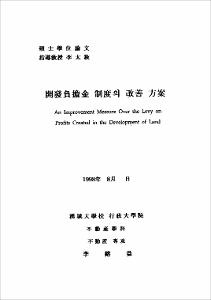開發負擔金 制度의 開善 方案
= (An) improvement measure over the Levy on profits created in the development of land
- Abstract
- The law of levy on profits created in land development is one of the laws that puts the public land concept in practice, legislated as the 4175th one in December 30, 1989 and being in force for eight years from March, 1990. Meanwhile, the system has improved continuingly, making a contribution to regulating indiscreet land development and stabilizing land price.
But lots of problems have occurred in the process of enforcing this levy system on profits created in land development. Especially, there are possibilities that this system's function becomes weaken greatly, unless the standard of land price determination at the point of beginning and termination and the criteria of development expense assessment are rationally applied.
The purpose of this study is, thus, to discuss some scheme to improve this levy system more effectively. First, the actual condition of imposing and collecting levy on profits created in land development is examined. And then, this system's problems and their reform measure are considered, by reviewing the following things separately: the business to which this system is applied, the size to which this system is applied, the assessment of land price and development expense, and the institutional and operating problems.
Despite the positive evaluation over this levy system, the styles to which this sytem is applied continue to expand, without considering the change of situation or business fluctuations. This results in dwindling down industries that must be fostered and developed to raise national competitiveness. The land price assessment, a standard of levy, is being particularly criticized.
In its early stage, land price was to be determined on the basis of levy termination and of appraised value by an appraisal agency composed of more than two expert witnesses. However, the government-set individual land price becomes new standard of assessment, and there is a narrow option for the standard land used in determination of government-set land price. And the low-ranking adminitrative officials who lack in expert knowledge take charge of choosing the standard land. Those structural weak points in the assessment of levy brings about a growing distrust in the office of administration.
The land price applied to the assessment of levy on benefits created in land development has to reflect the land's economic value exactly, and the assessment itself also should be done professionally and systematically. Accordingly, the existing assessment method simply depended on the normal value concept shall be removed, and the concept based on the most feasible price at which transaction might be done most frequently shall be adopted. It's needed to make an accurate survey over land characteristics and to explore a scientific analysis and assessment method over land price factors.
Besides, applying a progressive rate is more rational than the current one that applies 50% uniformly regardless of disparity in unrealized profit. The system shall change to be flexibly operated within the principle of equity and rationality. Especially, there is a need to justify the levy on profits created in land development, by specially managing the returned development profit and investing it in public welfare service for the community.
- Issued Date
- 1998
- Type
- Thesis
- Keyword
- 개발부담금; 부동산; public land use
- Files in This Item:
-
-
Download
 000000065896.pdf
기타 데이터 / 2.02 MB / Adobe PDF
000000065896.pdf
기타 데이터 / 2.02 MB / Adobe PDF
-
Items in Repository are protected by copyright, with all rights reserved, unless otherwise indicated.